Today I will try to explain, how can you generate 2D tile map and what noises can be useful for this purpose.
Noises
I found, that a lot of games uses noises to generate maps instead of getting only random numbers. I will show you Perlin and Simplex noise, and how I used it in my game.
Perlin Noise
Perlin Noise is first noise I used for map generation. It was developed by Ken Perlin in 1983. I used it for generate terrain tiles, like stone, dirt and also small caves.
C# Implementation
I used Monogame framework for Vector2 structure and generating texture from noises.
public static float[] Generate(int width, int height, Random random)
{
CalculatePermutation(out var permutation, random);
CalculateGradients(out var gradients, random);
var data = new float[width * height];
int octaves = 8;
/// track min and max noise value. Used to normalize the result to the 0 to 1.0 range.
var min = float.MaxValue;
var max = float.MinValue;
var frequency = 0.5f;
var amplitude = 1f;
for (var octave = 0; octave < octaves; octave++)
{
/// parallel loop - easy and fast.
Parallel.For(0
, width * height
, (offset) =>
{
var i = offset % width;
var j = offset / width;
var noise = Noise(i * frequency * 1f / width, j * frequency * 1f / height, permutation, gradients);
noise = data[j * width + i] += noise * amplitude;
min = Math.Min(min, noise);
max = Math.Max(max, noise);
}
);
frequency *= 2;
amplitude /= 2;
}
return data;
}
private static float Noise(float x, float y, int[] permutation, Vector2[] gradients)
{
var cell = new Vector2((float)Math.Floor(x), (float)Math.Floor(y));
var total = 0f;
var corners = new[] { new Vector2(0, 0), new Vector2(0, 1), new Vector2(1, 0), new Vector2(1, 1) };
foreach (var n in corners)
{
var ij = cell + n;
var uv = new Vector2(x - ij.X, y - ij.Y);
var index = permutation[(int)ij.X % permutation.Length];
index = permutation[(index + (int)ij.Y) % permutation.Length];
var grad = gradients[index % gradients.Length];
total += Q(uv.X, uv.Y) * Vector2.Dot(grad, uv);
}
return Math.Max(Math.Min(total, 1f), -1f);
}
private static void CalculatePermutation(out int[] permutation, Random random)
{
permutation = Enumerable.Range(0, 256).ToArray();
/// shuffle the array
for (var i = 0; i < permutation.Length; i++)
{
var source = random.Next(permutation.Length);
(permutation[source], permutation[i]) = (permutation[i], permutation[source]);
}
}
private static void CalculateGradients(out Vector2[] grad, Random random)
{
grad = new Vector2[256];
for (var i = 0; i < grad.Length; i++)
{
Vector2 gradient;
do
{
gradient = new Vector2((float)(random.NextDouble() * 2 - 1), (float)(random.NextDouble() * 2 - 1));
}
while (gradient.LengthSquared() >= 1);
gradient.Normalize();
grad[i] = gradient;
}
}
private static float Drop(float t)
{
t = Math.Abs(t);
return 1f - t * t * t * (t * (t * 6 - 15) + 10);
}
private static float Q(float u, float v)
{
return Drop(u) * Drop(v);
}
Results
For higher frequency and less octaves, result is more “noisy”.
| Octaves | Frequency | Result |
|---|---|---|
| 4 | 0.5 | 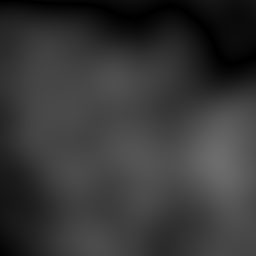 |
| 4 | 0.7 | 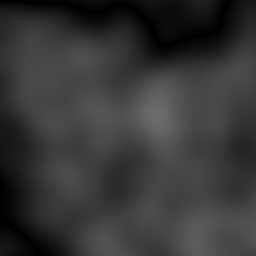 |
| 8 | 0.5 | 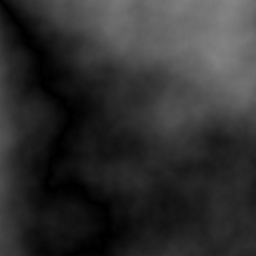 |
| 8 | 0.7 | 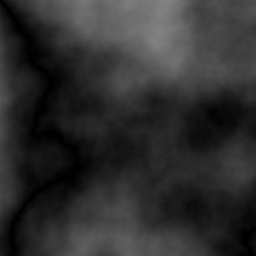 |
| 12 | 0.5 | 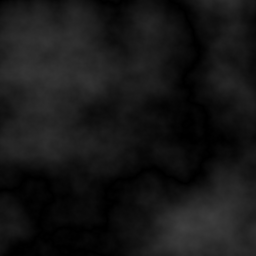 |
| 12 | 0.7 |  |
How to use in terrain generator?
For Perlin noise generator part I have noise result, list of object I want to be placed at this stage, and maxValue for ignoring value higher than it. With maxValue we can simply generate caves.
float[] result = noise.Generate(Global.Map.Size.X, Global.Map.Size.Y, random);
List<MapObject> mapObjects = new (); //Fill with dirt object, stone etc.
float maxValue = 0.2f; //Range 0-1, Higher value means less caves
Global.Map.MapCells.ForEach((p, c) =>
{
float val = result[p.Y * Global.Map.Size.X + p.X];
if (val < maxValue)
{
float step = maxValue / (float)mapObjects.Count;
for (int a = 0; a < mapObjects.Count; a++) //Can be done without for loop
{
if (val < (step * (float)a))
{
Global.Map.Place(mapObjects[a], p);
break;
}
}
}
});
Simplex Noise
Simplex Noise is comparable to Perlin Noise, but with less complexity and higher directional artifacts. I used it for ore generation.
C# Implementation
public static float[,] Generate(int width, int height, Random random)
{
CalculatePermutation(out var permutation, random);
float scale = 0.1f;
var values = new float[width, height];
for (var i = 0; i < width; i++)
for (var j = 0; j < height; j++)
values[i, j] = (Noise(i * scale, j * scale, permutation) * 128f + 128f) / 255f;
return values;
}
private static float Noise(float x, float y, int[] permutation)
{
const float F2 = 0.366025403f; // F2 = 0.5*(sqrt(3.0)-1.0)
const float G2 = 0.211324865f; // G2 = (3.0-Math.sqrt(3.0))/6.0
float n0, n1, n2; // Noise contributions from the three corners
// Skew the input space to determine which simplex cell we're in
var s = (x + y) * F2; // Hairy factor for 2D
var xs = x + s;
var ys = y + s;
var i = FastFloor(xs);
var j = FastFloor(ys);
var t = (i + j) * G2;
var X0 = i - t; // Unskew the cell origin back to (x,y) space
var Y0 = j - t;
var x0 = x - X0; // The x,y distances from the cell origin
var y0 = y - Y0;
// For the 2D case, the simplex shape is an equilateral triangle.
// Determine which simplex we are in.
int i1, j1; // Offsets for second (middle) corner of simplex in (i,j) coords
if (x0 > y0) { i1 = 1; j1 = 0; } // lower triangle, XY order: (0,0)->(1,0)->(1,1)
else { i1 = 0; j1 = 1; } // upper triangle, YX order: (0,0)->(0,1)->(1,1)
// A step of (1,0) in (i,j) means a step of (1-c,-c) in (x,y), and
// a step of (0,1) in (i,j) means a step of (-c,1-c) in (x,y), where
// c = (3-sqrt(3))/6
var x1 = x0 - i1 + G2; // Offsets for middle corner in (x,y) unskewed coords
var y1 = y0 - j1 + G2;
var x2 = x0 - 1.0f + 2.0f * G2; // Offsets for last corner in (x,y) unskewed coords
var y2 = y0 - 1.0f + 2.0f * G2;
// Wrap the integer indices at 256, to avoid indexing perm[] out of bounds
var ii = Mod(i, 256);
var jj = Mod(j, 256);
// Calculate the contribution from the three corners
var t0 = 0.5f - x0 * x0 - y0 * y0;
if (t0 < 0.0f) n0 = 0.0f;
else
{
t0 *= t0;
n0 = t0 * t0 * Grad(permutation[ii + permutation[jj]], x0, y0);
}
var t1 = 0.5f - x1 * x1 - y1 * y1;
if (t1 < 0.0f) n1 = 0.0f;
else
{
t1 *= t1;
n1 = t1 * t1 * Grad(permutation[ii + i1 + permutation[jj + j1]], x1, y1);
}
var t2 = 0.5f - x2 * x2 - y2 * y2;
if (t2 < 0.0f) n2 = 0.0f;
else
{
t2 *= t2;
n2 = t2 * t2 * Grad(permutation[ii + 1 + permutation[jj + 1]], x2, y2);
}
// Add contributions from each corner to get the final noise value.
// The result is scaled to return values in the interval [-1,1].
return 40.0f * (n0 + n1 + n2); // TODO: The scale factor is preliminary!
}
private static void CalculatePermutation(out int[] permutation, Random random)
{
permutation = Enumerable.Range(0, 256).ToArray();
permutation = permutation.Concat(permutation).ToArray();
/// shuffle the array
for (var i = 0; i < permutation.Length; i++)
{
var source = random.Next(permutation.Length);
(permutation[source], permutation[i]) = (permutation[i], permutation[source]);
}
}
private static int FastFloor(float x)
{
return (x > 0) ? ((int)x) : (((int)x) - 1);
}
private static int Mod(int x, int m)
{
var a = x % m;
return a < 0 ? a + m : a;
}
private static float Grad(int hash, float x, float y)
{
var h = hash & 7; // Convert low 3 bits of hash code
var u = h < 4 ? x : y; // into 8 simple gradient directions,
var v = h < 4 ? y : x; // and compute the dot product with (x,y).
return ((h & 1) != 0 ? -u : u) + ((h & 2) != 0 ? -2.0f * v : 2.0f * v);
}
Results
For ore generation in my game I used scale = 0.1f
| Scale | Result |
|---|---|
| 0.1 |  |
| 0.5 | 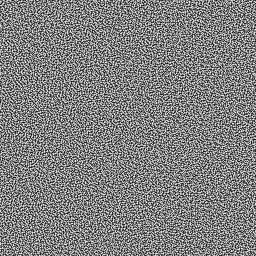 |
| 0.9 | 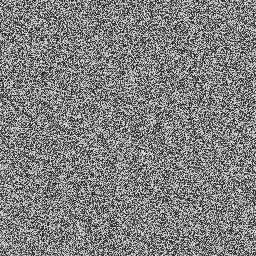 |
How to use?
For ore generation I’m filtering noise result and getting max value in specified area.
public readonly struct FreqEntry
{
public readonly int Power;
public readonly Point Point;
public FreqEntry(int power, Point point)
{
Power = power;
Point = point;
}
}
public static List<FreqEntry> HigherFrequences(float[,] result, int[] freq)
{
List<FreqEntry> points = new List<FreqEntry>();
result.ForEach((p, v) =>
{
for (int a = 0; a < freq.Length; a++)
{
Point maxPoint = GetMaxPoint(result, p, freq[a]);
points.Add(new FreqEntry(freq[a], maxPoint));
}
});
return points;
}
private static Point GetMaxPoint(float[,] array, Point p, int distance)
{
float max = 0;
Point maxPoint = Point.Zero;
for (int x = -distance; x <= distance; x++)
{
for (int y = -distance; y <= distance; y++)
{
int xn = p.X + x;
int yn = p.Y + y;
if (array.Inside(new Point(xn, yn)))
{
float v1 = array[xn, yn];
if (max < v1)
{
max = v1;
maxPoint = new Point(xn, yn);
}
}
}
}
return maxPoint;
}
int[] freq = new int[] { 4, 6, 8, 11 };
//4 = Common
//6 = Normal
//8 = Rare
//11 = Very rare
var freqPoints = NoisePatterns.HigherFrequences(result, freq);
foreach (var freqPoint in freqPoints)
{
var point = freqPoint.Point;
var power = freqPoint.Power;
List<MapObject> ent = new (); //Fill it with ores with rarity = power. In my project I stored it in Dictionary<int, List<MapObject>> where key is power, and this list is a value
if (ent.Count == 0)
{
continue;
}
Global.Map.Place(ent.ToArray().Random(random), point);
}
public static T Random<T>(this T[] array, Random random)
{
int index = random.Next(0, array.Length);
if (index == array.Length)
{
index--;
}
return array[index];
}
Summary
I hope this post is understandable. I’m trying my best to share my ideas with others ![]()